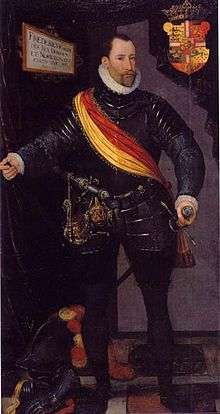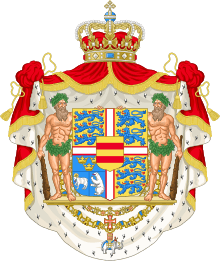Frederick II of Denmark
| Frederick II | |
|---|---|
 Portrait by Hans Knieper or Melchior Lorck, 1581. | |
| King of Denmark and Norway (more...) | |
| Reign | 1 January 1559 – 4 April 1588 |
| Coronation |
20 August 1559 Copenhagen Cathedral |
| Predecessor | Christian III |
| Successor | Christian IV |
| Born |
1 July 1534 Haderslevhus Castle, Haderslev, Denmark |
| Died |
4 April 1588 (aged 53) Antvorskov Castle, Zealand, Denmark |
| Burial | Roskilde Cathedral, Zealand, Denmark |
| Spouse | Sophie of Mecklenburg-Güstrow |
| Issue |
Elizabeth, Duchess of Brunswick-Lüneburg Anne, Queen of England and Scotland Christian IV, King of Denmark and Norway Ulrik, Prince-Bishop of Schwerin Augusta, Duchess of Holstein-Gottorp Hedwig, Electress of Saxony John, Prince of Schleswig-Holstein |
| House | Oldenburg |
| Father | King Christian III of Denmark |
| Mother | Dorothea of Saxe-Lauenburg |
| Religion | Lutheran |
Frederick II (1 July 1534 – 4 April 1588) was King of Denmark and Norway and Duke of Schleswig from 1559 until his death.[1]
King of Denmark
Frederick II was the son of King Christian III of Denmark and Norway and Dorothea of Saxe-Lauenburg, the daughter of Magnus I, Duke of Saxe-Lauenburg. He was hailed as successor to the throne of Denmark in 1542, and of Norway in 1548. Unlike his father, King Frederick II was strongly affected by military ideals. Already as a young man, he made friendships with German war princes. In 1552, Steward of the Realm, Peder Oxe (1520–1575), had been raised to Councillor of State (Rigsraad). During the spring of 1557, Oxe and the King had quarreled over a mutual property exchange. Failing to compromise matters with the King, Oxe had fled to Germany in 1558. However, financial difficulties arose during the stress of the Northern Seven Years' War. King Frederick II won his first victory with the conquest of Dithmarschen in Schleswig-Holstein under Johan Rantzau, during the summer of 1559.[2]
From his predecessor, he inherited the Livonian War. In 1560, he installed his younger brother, Magnus of Holstein (1540–1583), in the Bishopric of Ösel–Wiek. King Frederick II largely tried to avoid conflict in Livonia and consolidated amicable relations with Tsar Ivan IV of Russia in the 1562 Treaty of Mozhaysk.[3] His brother Magnus was later made titular King of Livonia, as a vassal of Tsar Ivan IV.
King Frederick's competition with Sweden for supremacy in the Baltic broke out into open warfare in 1563, the start of the Northern Seven Years' War, the dominating conflict of his rule. He tried in vain to conquer Sweden, which was ruled by his cousin, King Eric XIV. It developed into an extremely expensive war of attrition in which the areas of Scania were ravaged by the Swedes, and Norway was almost lost. During this war, King Frederick II led his army personally on the battlefield, but without much result. The conflict damaged his relationship with his noble councillors; however, the later Sture Murders of 24 May 1567 by the insane King Eric XIV in Sweden, eventually helped stabilize the situation in Denmark.
After state finances collapsed during the years 1566 to 1567, King Frederik II called Peder Oxe home to address the kingdom's economy. The taking over of Danish administration and finances by the able councillor, provided a marked improvement for the national treasury. Councillors of experience, including Niels Kaas, Arild Huitfeldt, and Christoffer Valkendorff, took care of the domestic administration. Subsequently, government finances were put in order and Denmark's economy improved. One of the chief expedients of the improved state of affairs was the raising of the Sound Dues. Oxe, as lord treasurer, reduced the national debt considerably and redeemed portions of crown lands.[4][5][6]

After King John III of Sweden, King Eric's successor, refused to accept a peace favoring Denmark in the Treaties of Roskilde (1568), the ongoing war dragged on until it was ended by a status quo peace in the Treaty of Stettin (1570), that let Denmark save face but also show limits of Danish military power.[7] After the war, King Frederick II kept the peace without giving up his attempt of trying to expand his prestige as a naval ruler. His foreign politics were marked by a moral support of the Protestant powers – but at the same time by a strict neutrality.[8]
A period of affluence and growth followed in Danish history. In 1567, King Frederick II founded Fredrikstad in Norway. Frederik II Upper Secondary School in Fredrikstad, one of the largest schools of its kind in Norway, is named after Frederick.[9] He also rebuilt Kronborg in Elsinore from a medieval fortress into a magnificent Renaissance castle, between 1574 and 1585.[10] In 1585, he visited Norway as king when he came to Båhus. He was a major patron and close personal friend of the famous astronomer, Tycho Brahe (whose step-father, Jørgen Thygesen Brahe, had rescued the King from drowning, catching pneumonia and dying as a result).[11][12]
King Frederick II stands as a typical renaissance ruler of Denmark. He was a lover of hunting, wine, women, and feasts. As a person, he was often described as hot-headed, vain, courageous, and ambitious.
Family and children
As a young man, Frederick II had desired to marry his mistress, Anne of Hardenberg, who had served as a lady-in-waiting to his mother, the Dowager Queen Dorothea of Denmark.[13] He had also wooed Queen Elizabeth I of England, an initiative which made him Knight of the Garter. On 20 July 1572, he was married to Sophia of Mecklenburg-Güstrow, a descendant of King John of Denmark, and also his own first half-cousin, through their grandfather, Frederick I, King of Denmark and Norway. Sophia was the daughter of Ulrich III, Duke of Mecklenburg-Güstrow and Elizabeth of Denmark. Frederick and Sophia had eight children:
- Elizabeth of Denmark (25 August 1573 – 19 June 1625), married in 1590 to Henry Julius, Duke of Brunswick-Lüneburg.
- Anne of Denmark (12 December 1574 – 2 March 1619), married on 23 November 1589 to King James VI of Scotland (later also King James I of England).
- Christian IV, King of Denmark and Norway (12 April 1577 – 28 February 1648)
- Ulrik of Denmark (30 December 1578 – 27 March 1624 in Rühn), last Bishop of the old Schleswig see (1602–1624), and as Ulrich II, Administrator of the Prince-Bishopric of Schwerin (1603–1624). He married Lady Catherine Hahn-Hinrichshagen.
- John August of Denmark (1579–1579), died in infancy.
- Augusta of Denmark (8 April 1580 – 5 February 1639), married on 30 August 1596 to John Adolf, Duke of Holstein-Gottorp.
- Hedwig of Denmark (5 August 1581 – 26 November 1641), married on 12 September 1602 to Christian II, Elector of Saxony
- John of Denmark, Prince of Schleswig-Holstein (9 July 1583 – 28 October 1602)
Ancestry
References
- ↑ Frederik 2 (Dansk Konge)
- ↑ "Johan Rantzau". Den Store Danske. Retrieved August 15, 2016.
- ↑ "Magnus, Konge af Lifland, 1540-83". Dansk biografisk Lexikon. Retrieved August 15, 2016.
- ↑ "Christian III, Peder Oxe and the 1557 Meeting of the Great Council: Royal Purges and Succession". historisktidsskrift.dk. Retrieved August 15, 2016.
- ↑ "Oxe, Peder, 1520-75, Rigshofmester". Dansk biografisk Lexikon. Retrieved August 15, 2016.
- ↑ Frederik 2 (Danish Kings and their History)
- ↑ "Frederik 2". Store norske leksikon. Retrieved August 15, 2016.
- ↑ "Frederik 2". Norsk biografisk leksikon. Retrieved August 15, 2016.
- ↑ Fredrikstad museum Archived 21 January 2008 at the Wayback Machine.
- ↑ Frederik II (1559–1588) (Familien Sørensens Hjemmeside – og Rejseholdet)
- ↑ "Life and Times of Tycho Brahe". reformation.org. Retrieved August 15, 2016.
- ↑ "Jørgen (Thygesen) Brahe". Den Store Danske. Retrieved August 15, 2016.
- ↑ Anne Corfitzdatter Hardenberg of Helsingborg (Worldwide Guide to Women in Leadership)
External links
| Wikimedia Commons has media related to Frederick II of Denmark. |
- The Royal Lineage at the website of the Danish Monarchy
- Frederik II at the website of the Royal Danish Collection

Frederick II Born: 1 July 1534 Died: 4 April 1588 | ||
| Regnal titles | ||
|---|---|---|
| Preceded by Christian III |
King of Denmark and Norway 1559–1588 |
Succeeded by Christian IV |
| Preceded by Christian III John II the Elder and Adolf (in condominial rule) |
Duke of Holstein and Schleswig 1559–1588 with John II (1559–1580) Adolf (1559–1586) Frederick II (1586–1587) Philip (1587–1588) |
Succeeded by Christian IV and Philip |
